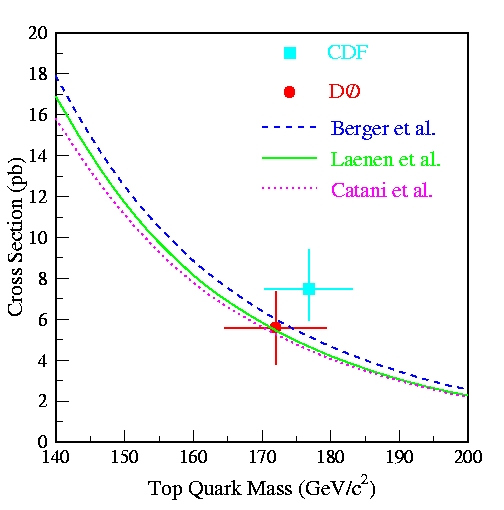
July 1997
Since our co-discovery of the top quark in 1995, we have set upon a rigorous study of its properties. The top quark is the twelfth (and final?) fundamental constituent of matter to be discovered. One important measurement we have just published is the top quark pair production cross section.
In the simplest terms the cross section is a quantity that defines how often a process will occur under specified conditions. Here we ask the experimental question: What percent of the time are top quarks produced when we collide protons into antiprotons head-on with a total energy of 1.8 TeV? The experimental procedure used to determine this comes down to counting the number of times top quarks are seen in our detector and dividing by the total number of collisions observed.
This may sound easy but the art lies in identifying which events are top quarks and which events are the result of creating particles of lesser mass. Fortunately the current theory of the basic nature of the universe, the Standard Model, gives us guidance on how the top quark will be produced and how it will decay.
From the theory we expect top quarks to be produced predominately in pairs, and that each top quark will decay into the lighter mass b quark and a W boson (a carrier of the weak force). The top quark lives only for a very short period of time before it decays, and it is through the decay products that we infer the existence of the top quark. Signatures of top pair production depend on the decay of the two W bosons in the event. The W can decay to quarks (2/3 of the time) which appear as a collimated spray or jet of particles in our detector, or it can decay to one of the three flavors of charged lepton and neutrino. Our detector is best suited to flag events with electrons and/or muons, so the best signatures to reliably see top quark decay involve one or both W's decaying to an electron or muon.
We scan our data for events with these signatures and count them. However, our job is complicated by competing processes that can sometimes mimic the top pair decay events that we seek. So we have to carefully study these processes to design selection criteria that reject such events while at the same time keep events containing top quarks. One such selection technique takes advantage of the two jet-producing b quarks present in the top pair decays; requiring the presence of at least two jets increases the likelihood that the event came from top. Applying this and other selection techniques we then carefully compute the expected fraction of our events that could come from these processes, called background processes, and subtract this number from our total count.
The final tally from our selection analysis comes to 9 events where both W's go to leptons and 30 events where only one W goes through lepton decay. For the total of 39 events we have carefully estimated the number background events to be 13.7, with an uncertainty of 2.2 events. We now compare these numbers to how many collisions occurred in our detector. We collected data almost continuously, with only a couple of breaks, from 1991 to 1996. While running we have a collision in our detector roughly once every 3.5 micro seconds, corresponding to approximately 10 trillion collisions in this five year period. Taking into consideration the decay signatures we can't utilize in our count, and a precisely determined efficiency for detecting the signature we are looking for, we arrive at our published cross section measurement of 5.5 picobarns with an uncertainty of 1.8 picobarns. This translates to roughly one top quark pair produced out of every 15 billion proton-antiproton collisions!
Now a word about the cross section unit of measurement, the barn (b), defined as 10-28 m2. Cross sections are discussed in terms of the area of overlap of the interacting fields of the particles in proximity of each other. The top quark cross section is measured in picobarns (pb = 10-12b) which is equivalent to 10-40 m2! A very small number reflecting the small number of top pairs produced in our experiment and the challenge of finding and measuring them. The small probability of producing top quarks is in part due to how heavy they are. Even with the tremendous head on collision energy provided by the Tevatron accelerator, top pair production is not far above the needed threshold energy requirement.

The cross section and mass are just the beginning of the probes of the Standard Model that studies of top will afford. The DØ collaboration is getting ready for further experiments in the near future with an improved accelerator and upgraded detector. Studies of the top quark will be a "top" priority, and with our cross section measurement in hand we can now reliably estimate that we will have tens of times more statistics in our data sample enabling precision study of this heavyweight member of the quark family.
A copy of our paper "Measurement of the Top Quark Pair Production Cross Section in pbarp Collisions", published in Physical Review Letters 79, 1203 (1997), is available from hep-ex/9704015.
For further information contact Dr. Raymond Hall, email: raymond@fnal.gov